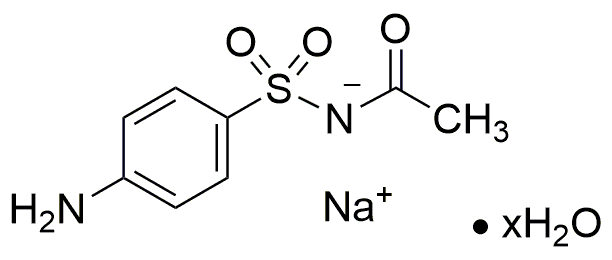Sulfacetamide sodium salt hydrate is widely utilized in research focused on:
- Pharmaceuticals: Commonly used as an antibacterial agent in topical formulations to treat skin infections and acne, providing effective relief with minimal side effects.
- Ophthalmology: Employed in eye drops to treat bacterial conjunctivitis, helping to reduce inflammation and promote healing in patients.
- Cosmetics: Incorporated into skincare products for its anti-inflammatory properties, making it beneficial for sensitive skin and conditions like rosacea.
- Laboratory Research: Utilized in microbiological studies to assess bacterial resistance and efficacy of antibiotics, aiding researchers in developing new treatments.
- Veterinary Medicine: Used in formulations for animals to treat infections, ensuring the health and well-being of pets and livestock.
General Information
Properties
Safety and Regulations
Applications
Sulfacetamide sodium salt hydrate is widely utilized in research focused on:
- Pharmaceuticals: Commonly used as an antibacterial agent in topical formulations to treat skin infections and acne, providing effective relief with minimal side effects.
- Ophthalmology: Employed in eye drops to treat bacterial conjunctivitis, helping to reduce inflammation and promote healing in patients.
- Cosmetics: Incorporated into skincare products for its anti-inflammatory properties, making it beneficial for sensitive skin and conditions like rosacea.
- Laboratory Research: Utilized in microbiological studies to assess bacterial resistance and efficacy of antibiotics, aiding researchers in developing new treatments.
- Veterinary Medicine: Used in formulations for animals to treat infections, ensuring the health and well-being of pets and livestock.
Documents
Safety Data Sheets (SDS)
The SDS provides comprehensive safety information on handling, storage, and disposal of the product.
Product Specification (PS)
The PS provides a comprehensive breakdown of the product’s properties, including chemical composition, physical state, purity, and storage requirements. It also details acceptable quality ranges and the product's intended applications.
Certificates of Analysis (COA)
Search for Certificates of Analysis (COA) by entering the products Lot Number. Lot and Batch Numbers can be found on a product’s label following the words ‘Lot’ or ‘Batch’.
*Catalog Number
*Lot Number
Certificates Of Origin (COO)
This COO confirms the country where the product was manufactured, and also details the materials and components used in it and whether it is derived from natural, synthetic, or other specific sources. This certificate may be required for customs, trade, and regulatory compliance.
*Catalog Number
*Lot Number
Safety Data Sheets (SDS)
The SDS provides comprehensive safety information on handling, storage, and disposal of the product.
DownloadProduct Specification (PS)
The PS provides a comprehensive breakdown of the product’s properties, including chemical composition, physical state, purity, and storage requirements. It also details acceptable quality ranges and the product's intended applications.
DownloadCertificates of Analysis (COA)
Search for Certificates of Analysis (COA) by entering the products Lot Number. Lot and Batch Numbers can be found on a product’s label following the words ‘Lot’ or ‘Batch’.
*Catalog Number
*Lot Number
Certificates Of Origin (COO)
This COO confirms the country where the product was manufactured, and also details the materials and components used in it and whether it is derived from natural, synthetic, or other specific sources. This certificate may be required for customs, trade, and regulatory compliance.

